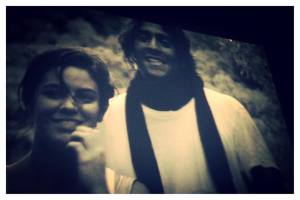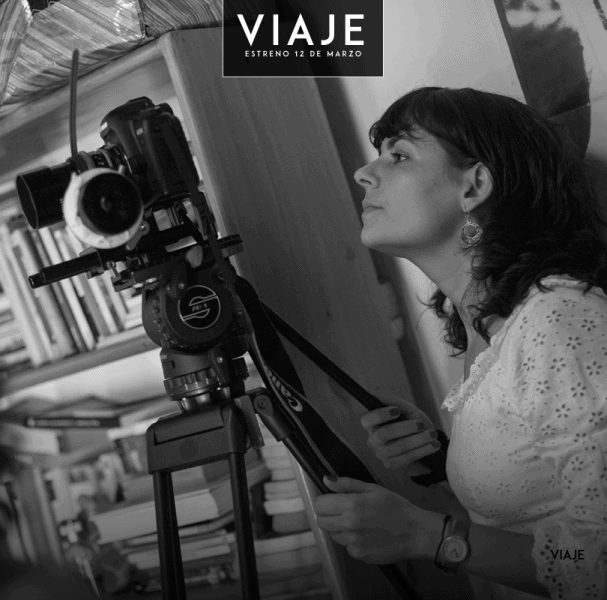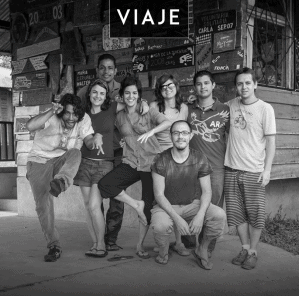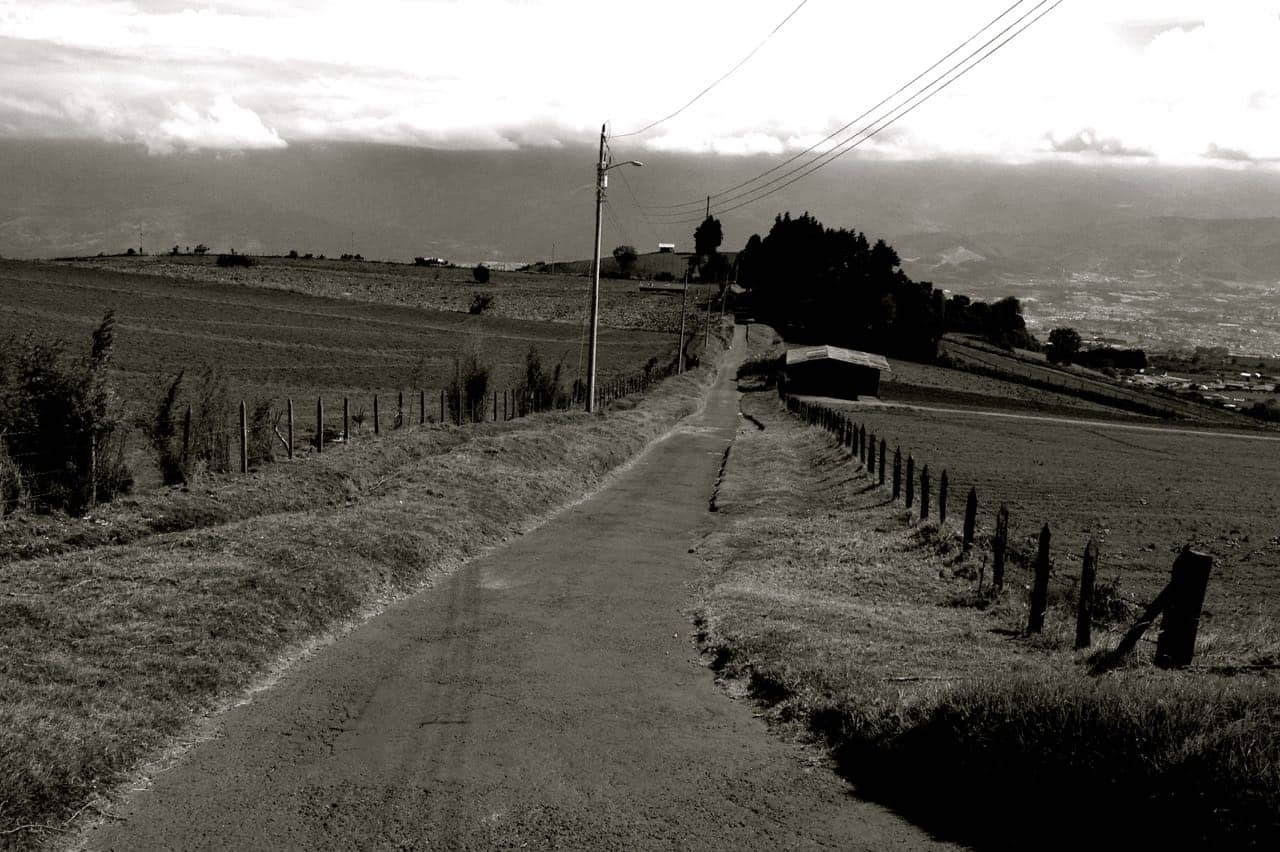A guy is wearing a bear suit. But that’s fine, because he’s at a costume party. He’s very drunk, and so is everybody else. Halfway up a staircase, he stumbles into a young woman he’s never met. She’s dressed in a school uniform, the kind worn by elementary school kids. He’s a tall guy, she’s much shorter, so when he randomly decides to kiss her, it’s doubly awkward. She recoils, he sloppily apologizes, and then he heads to the bathroom.
The girl looks miffed – at first. But then something happens: She isn’t as upset about his advance as she thought. Actually, he’s kind of cute, for a guy dressed like a teddy bear. Something clicks in her mind, so she ascends the stairs, finds the guy as he’s about to leave the bathroom, and proceeds to make out with him.
That’s how the film “Viaje” starts. It’s a boy meets girl story, but also a boy and girl ride in cab to his house… boy suggests they take bus to Rincón de la Vieja National Park… boy and girl hike around in the rain… boy climbs a tree but girl is scared to… boy and girl shack up in tent… girl reveals secret that makes boy reconsider what they’re doing… and boy wanders around sulfuric fumaroles while girl contemplates her life… kind of story.
The title can suggest several things in English – trip, travel, trip, vacation – but here it is best translated as “journey.”
•
“Have you seen ‘Viaje’?” asked my friend Beto a few weeks ago.
“Have I seen… travel?”
“No, it’s a movie called ‘Viaje.’ You haven’t heard of it?”
“Never. A Costa Rican film?”
“Yeah. It came out a little while ago.” He paused. “It looks pretty good. But I don’t think it’s doing very well.”
Since I write about arts and travel, my email absorbs press releases like a digital sponge. I miss some events, because people overlook the country’s English-language newspaper, or they think we know about it already, or they don’t think our readers will care. But this was a surprise: How had I missed an art film about travel?
I looked up the trailer.
As the two-minute promo transpired, my smile broadened. The story looked simple and sweet. From what I could tell, the film had only two characters. The light piano soundtrack and realistic dialogue took me by surprise. It was like nothing I had ever seen in Costa Rica. And most surprisingly, it was filmed in black and white – a daring choice, if you’re shooting in one of the most colorful landscapes in the world.
I checked out local cinemas, hoping it was still screening, but my search came up with nothing. The big theaters in Escazú had shown several Costa Rican films, but not “Viaje.” I pursued the smaller theaters, Sala Garbo and Cine Magaly, but still nothing. Finally I looked up the “Viaje” Facebook page and sent a private message.
“Hi,” I wrote. “I would love to see ‘Viaje.’ Is it playing in local cinemas?”
The next day, someone replied: “Hi, Robert, at the moment we’re at CCM Cinemas in San Carlos.”
San Carlos? I thought. That’s like three hours away.
Not long afterwards, I was standing in line at Auto Mercado, waiting to pay my phone bill, when I saw the cover of Perfil, the glossy lifestyle magazine. On the cover was a smiling, bright-eyed young woman wearing a bear costume. She was not the leggy supermodel that usually poses for Perfil’s covers, and I squinted at the surprising visage. Who is that? I wondered. She looked strangely familiar, like someone I would have gone to college with. Come to think of it, I knew dozens of zany friends back in Pittsburgh who would happily throw on a bear costume.
Then I saw her name: Paz Fabrega, director of “Viaje.”
And I had a sudden desire to meet her. Some day.
•
You can’t really call it a genre, exactly, but there are a lot of films like “Viaje” – small, low-budget, with only a handful of actors and locations, shot in black and white. Until recently, this was an economic necessity. Printing color film was cripplingly expensive, and a printed reel was required to screen a film in a movie theater. That has always been the case, since the days of Technicolor and Cinemascope. Just recently, cinemas have converted to an all-digital format, but the black and white debut has long been an auteur’s right of passage.
But these early efforts are often a director’s most memorable: Films like “Clerks” and “π” have massive cult followings. One of my favorite indie flicks is “Coffee and Cigarettes,” a celebrity-packed series of vignettes by Jim Jarmusch that has people like Bill Murray and The White Stripes talking nonsense while drinking coffee and chain-smoking. Some directors make low-budget black and white movies because they prefer the challenge, the aesthetic, and the simplicity: Woody Allen was world-famous when he produced “Manhattan,” and Noah Baumbach filmed “Frances Ha” on a shoestring, despite his access to a far meatier budget.
“I can see why it didn’t do well,” I said to Beto, some days later.
“How do you mean?”
“That kind of movie is a tough sell.”
“Viaje” had also come out at the same time as “Maikol Yordan y El Viaje Perdido,” the blockbuster comedy that is now the best-attended film in Central American history. “Viaje” seemed like the polar opposite of “Maikol Yordan” – raw, realistic, and quietly good-humored. It would demand more patience and sensitivity from a Costa Rican audience.
In my case, I couldn’t find “Viaje” anywhere, so I gave up. I had missed my chance. I hoped that it would appear on DVD or Vimeo on Demand. I’d have to wait until it floated around the Internet in future years so that I could finally check it out.
Then I received a serendipitous email: A woman named Vanessa Erazo was promoting a short documentary about Paz Fabrega. As it happened, Fabrega was in New York City, where “Viaje” was screening at the Tribeca Film Festival – one of the most distinguished festivals in the world.
Erazo’s group was the Remezcla Content Network, which promotes young, Hispanic movers and shakers across the U.S. and Latin America. I was smitten: It was exciting to see Fabrega get some recognition in a place as cutthroat and competitive as New York. I wrote Erazo and asked if she knew how to contact Fabrega.
That same day, I received this message:
Dear Robert,
Vanessa from Remezcla forwarded your interview request on to me. Thanks for your interest in Viaje!
I’m not certain, but I believe we have met before, I’m the owner/sometimes chef/sometimes waitress of Café Rojo?…
•
Here is the real point of this story, and the reason I fell for “Viaje”: It triggered that peculiar feeling, so common among college students and backpackers, singles and dropouts and divorcees and expats, when you’re so free and unattached, so not-busy, so open to whatever, that you stumble blindly into one passive adventure after another.
Fabrega told me that there would be a special outdoor screening of “Viaje” at Galería Escazú that very Saturday. At it happens, Galeria Escazú lies about a kilometer from my apartment. As evening fell over the city, I strolled over to the yard where the film would play. I expected a smattering of films buffs. I liked the idea of an outdoor projection, as it reminded me of the drive-ins and screenings in public parks I had often enjoyed back in Pittsburgh.
The place was packed. Lawn chairs were arranged on the grass, and every one was occupied. Easily 200 people were jammed into the patio, and more stood behind them. I settled into a patch of grass, and only a minute after I arrived, the movie started to play. There was no fanfare, no elaborate introduction. Fabrega herself was still in New York, and no one seemed interested in a curtain speech. For the next hour, we were all happily adrift in the world of “Viaje.”

Fabrega directed the film with long takes – each shot can last several minutes, statically positioned on a tripod. Entire scenes unfold without cutting, zooming, or shifting focus. The dialogue is so natural that it sounds improvised, and as I later learned, “Viaje” had no script. The actors were given a basic narrative, and they sculpted the scenes as they went.
As I watched these two characters ride in a taxi, miss a bus, run through the rainforest, set up a tent, skinny-dip in a river, make love on a railing, and otherwise wend their way through an impromptu weekend, I swelled with memories. I remembered sitting on porch-couches with newfound acquaintances in urban Pittsburgh, rooftop parties on semi-abandoned buildings, gabbing with friends on bridges in the middle of the night as we watched clouds roll over the city. Those were the days of piecemeal jobs and ramen noodles, afternoons at the Laundromat, and neighbors fresh out of jail. I had no car and had to visit the public library to check my email. Evening hang-outs went till four in the morning and it seemed like every person I met could play guitar. It was a hard way to live, uninsured, scraping by, waiting hours for buses that often never came. But one small, good thing so easily led to another. Small, good things were all I needed.
It was exactly 10 years ago that I met a girl on the South Side of Pittsburgh, at a dive bar full of tiki torches and dirt-cheap beer. We were both broke and aimless. We had recently terminated awful relationships and had no particular life plans. All we could sense in each other was a good vibe. And a decade later, we’re married and live in Costa Rica.
“Viaje” is not the best film I’ve seen in 2015, nor was it the best film I saw that month. But I had never seen anything that captured this spirit so effortlessly. I knew these characters as well as I knew myself. In the sultry evening air of Galería Escazú, surrounded by scruffy students and hipsters, the flashbacks and film blended together, until it was hard to distinguish one life from the other.
•
Then, out of nowhere, “Viaje” won critical acclaim. Not from Costa Ricans, and certainly not from La Nación, whose film critic ruthlessly panned it. The acclaim came from the most unlikely source of all – The New York Times.
“The best entry I’ve seen in the competition,” wrote critic Stephen Holden. “The outing is a bittersweet romantic idyll whose outcome is a question that hangs in the air. There is no happy ending in this lustrous movie that celebrates a sweet, playful moment shared by two people who know how to live in the present and savor what life has to offer.”
For fledgling filmmakers, the film festival circuit can be a blessing and a curse. On the one hand, they are hubs of creativity, where artists and industry people can gather and celebrate their hard work. Guests can see premieres and hard-to-find classics that are impossible to find anywhere else. A film festival can be orgiastically fun. Distributors routinely discover obscure films and arrange deals.
But festivals can also be a slog. A film may screen all over the world, accumulating random awards like “Honorable Mention Documentary Short” and “Activism Award,” yet it might never debut in an actual theater. There are thousands of festivals, which draw tens of thousands of movies, and only a fraction of those will reach a wider audience.
Whatever “Viaje’s” future, a good review from the Gray Lady is a powerful benediction. After crashing and burning in its home country, “Viaje” had made a significant journey, and at last its creators could enjoy a small, good thing.
•
I had met Paz Fabrega, without even realizing it. Of all the eateries in Barrio Amón, Café Rojo is my favorite place to grab lunch. The first time I ate there, I loved the atmosphere so much that I rushed back to the office and wrote a gushing review of the joint. The hardwood floors and bistro furniture reminded me of my favorite haunts in Pittsburgh, the bohemian nooks that I had missed so much. I loved the French ballads that played over its speakers. I loved the eccentric fusion of Vietnamese noodle bowls and hearty sandwiches. I savored the rich coffee and wide range of teas. I had no idea who owned it, but I knew I’d have to go back – and so I have, almost every week since.
Our first meeting had been brief and nondescript, several months after I’d become a regular. I’d heard through the grapevine that Fabrega had appreciated the review, but it had seemed tacky to introduce myself as the critic who had praised the place. I had assumed she still had no idea who I was, that I was just some happy-go-lucky pelirrojo who loved Asian cuisine. As is my custom – when not interviewing people – I immediately forgot her name.

As I strolled down the street toward Café Rojo, I started to feel a little star-struck. This is not something I experience often, but when it happens, it happens hard. I once met the author Michael Ondaatje at a party and was paralyzed with euphoria. Stardom itself doesn’t impress me, but when someone has affected me on a deeply personal level, I’m thunderstruck in their presence.
Fabrega sat Indian-style on a wooden bench. I ordered coffee.
“When I started to make ‘Viaje,’” she told me, “I thought, ‘I’m not going to tell anybody about it. I’m going to produce on it on my own and do it with friends.”
Fabrega grew up in San Pedro and studied communications at the University of Costa Rica. The university didn’t teach photography, so she took classes at another school in Alajuela. When she decided to become a filmmaker, Fabrega spent two years at the London Film School. She landed a writer’s residency at Binger Filmlab in Amsterdam, where she began work on her first feature film, “Agua Fría del Mar.”
“It is a very difficult film to watch,” said Fabrega. She compared “Agua Fría” to the films of David Lynch, particularly “Mulholland Drive.” The story is dreamlike and the narrative unreliable. Meanwhile, Fabrega incorporated a wide range of talent from multiple countries. “The things we did were very expensive and very complicated.”
The film screened at a few cinemas, but Fabrega had no illusions about her surreal art film. She knew that audiences would struggle with its content, especially in Costa Rica, and she didn’t expect much attention. She wanted “Viaje” to be different – something simple and intimate, something she could film on the down low. If she had used unionized actors and a studio rubric, the film should have cost something like $50,000, but instead she spent a grand total of $3,000.
Fabrega had known Fernando Bolaños, one of the two principal actors, since Fabrega was 15 years old, when they performed in a theater club together. Fabrega, Bolaños and actress Kattia Gonzáles instantly bonded over the film’s subject matter.
“We were all at a similar place in our lives,” said Fabrega. “When we see romantic films, where the characters live happily ever after, it’s just not true. We never think, ‘This is who I’m going to spend the rest of my life with.’ But at some time in your life, you feel free. You leave everything behind. When I was younger, it happened a lot. So the actors had a lot of input into what happened in the scenes.”
As Fabrega described the process, she sounded like no other filmmaker I’d ever met. Over the years, I’ve conversed with many directors about technical concerns, budgeting problems, pre-production sagas, and marketing hooks. Moviemaking is such an exhausting collaboration that success is a vital preoccupation. Even the lowliest filmmakers name-drop where they can – anything to give their project credibility. But Fabrega didn’t sound anything like that. She had no idea how, or even whether, she would distribute the film. It was only after friends and colleagues saw “Viaje” and encouraged her to release it in theaters that she decided to take the plunge.
“So I think it’s safe to say that ‘Viaje’ didn’t do very well,” I said.
“It did terrible!” Fabrega exclaimed, looking shell-shocked and even a little self-effacing. “It was a disaster. I wasn’t sure how well it would do, but I think we alienated everybody.”
Fabrega didn’t cut the trailer herself, but she liked it. The problem, she has theorized in retrospect, is that the trailer makes “Viaje” look like a romantic comedy, which turned off the indie film crowd. But “Viaje” also looked too “artsy” to attract a mainstream audience. In the end, few people wanted to take the time to see it, because everyone felt that the film was designed for someone else.

“I think Costa Rica is kind of neurotic about its cinema,” said Fabrega. She didn’t sound bitter, but it had been a tough pill to swallow – this lack of enthusiasm for “Viaje” on its home turf. “It’s like you’re not allowed to present things in the way that filmmakers everywhere else do.” She was particularly surprised by some comments on social media, which suggested that the protagonists were no-account vagabonds. “People said that these characters were part of a lost generation. But that’s not what it’s about. These people are allowed to have fun. They’re allowed to go somewhere, to have one weekend.”
“So then there was Tribeca,” I offered. “And it’s kind of a Cinderella story.”
“I have no idea what happened!” Fabrega said.
When “Viaje” was first entered at the film festival, she recalled, it was only intended to screen publically, and that would all. But when Fabrega arrived, she learned that the film had been promoted to the competition level. This was completely unexpected, and she’s still not sure how it transpired. Suddenly the film was open to critics, judges, awards, and more serious attention from the public.
Even today, The New York Times’ accolades still astonish her.
“It definitely makes you feel good,” she said.
“Do you think you’ll make another one?” I asked.
“Oh, yes,” she said, brightening. “I’ve already started writing it.”
•
I left Café Rojo deeply satisfied. Fabrega had filled in the blanks for a story that had mystified and enchanted me for nearly two months. But it was even more than that.
For years, I have worked in the theater, writing plays, directing plays, performing in plays, and spending the creative lulls watching plays and reading scripts. I taught playwriting for five years, advising undergrads on how best to tell their stories onstage. I have long flirted with the idea of making a movie, and here again “Viaje” struck a chord: It was the kind of movie I would want to make. It wasn’t the story I’d want to tell, or even the cinematography that I envision, but the process – the stripped-down, gung-ho spirit of its creation, the close collaboration with people I already admire and respect – is the part of “Viaje” that inspires me above all.
I had nearly reached a busy street corner when a bus roared by. The sign above its windshield indicated a distant Caribbean town. I hadn’t left San José in some weeks. My inbox awaited me. Deadlines loomed. Phone calls had to be made. But sometime soon, I would board one of those buses. I’d go with a backpack and a few sets of clothes. I wouldn’t trifle with reservations or plans. I’d switch off my phone. And then I’d just go, and see what happens.
•
Robert Isenberg is a staff writer for The Tico Times. His book, The Green Season, will be available soon. Visit him at robertisenberg.net.

